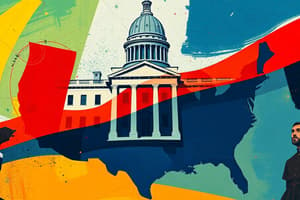Podcast
Questions and Answers
What is the primary purpose of the system of checks and balances in the U.S. Constitution?
What is the primary purpose of the system of checks and balances in the U.S. Constitution?
- To allow the President to make laws without Congressional approval
- To ensure that each branch of government has equal power
- To give the Supreme Court the power to declare laws unconstitutional
- To prevent any one branch of government from becoming too powerful (correct)
Which of the following is a characteristic of Republicanism?
Which of the following is a characteristic of Republicanism?
- Strong central government with limited individual freedoms
- Emphasis on the common good and the public interest (correct)
- Advocacy for the abolition of slavery
- Protection of individual rights and liberties
What is the primary function of the Bill of Rights?
What is the primary function of the Bill of Rights?
- To outline the powers of the state governments
- To protect individual rights and liberties from government interference (correct)
- To provide a process for amending the Constitution
- To establish the framework of the federal government
Which of the following powers is denied to the federal government by the Constitution?
Which of the following powers is denied to the federal government by the Constitution?
What is the term for the shared powers of the federal and state governments?
What is the term for the shared powers of the federal and state governments?
Flashcards are hidden until you start studying
Study Notes
Constitutional Underpinnings
- Federalism is a system of government where power is divided between a central authority and smaller units, such as states or regions.
- Separation of Powers is a system that divides power among three branches of government: Legislative, Executive, and Judicial.
- Checks and Balances ensure that each branch has some authority to limit the actions of the other branches, preventing any one branch from dominating the others.
Foundations of U.S. Political Thought
- The Enlightenment was a philosophical movement that emphasized reason, individualism, and democracy, influencing the development of U.S. political thought.
- Liberalism is a political ideology that emphasizes individual rights, liberty, and limited government.
- Republicanism is a political ideology that emphasizes civic virtue, the common good, and the protection of individual rights.
The Constitution
- The Constitution was written in 1787 and ratified in 1788, providing the framework for the U.S. government.
- The Constitution's Historical Context was influenced by the American Revolution, the Articles of Confederation, and the need for a stronger central government.
- The Constitution's Structure consists of a Preamble, seven Articles, and 27 Amendments.
- The Bill of Rights, comprising the first 10 Amendments, guarantees individual rights and freedoms.
Federalism in Action
- Concurrent Powers are powers shared by both the federal government and the states, such as taxation and lawmaking.
- Reserved Powers are powers reserved exclusively for the states, such as regulating intrastate commerce.
- Denied Powers are powers that are prohibited to the states, such as coining money or making treaties.
Studying That Suits You
Use AI to generate personalized quizzes and flashcards to suit your learning preferences.




